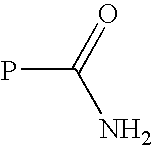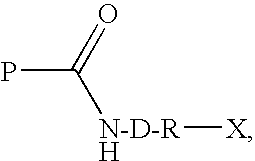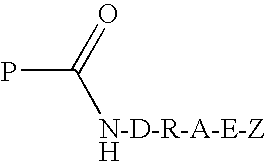Transglutaminase Mediated Conjugation of Peptides
a technology of transglutaminase and peptide, which is applied in the field of posttranslational conjugation of peptides, can solve the problems of severe limitation and limit the attachment point of c-terminal amino acid residues, and achieve the effect of improving the pharmacological properties of peptides
- Summary
- Abstract
- Description
- Claims
- Application Information
AI Technical Summary
Benefits of technology
Problems solved by technology
Method used
Image
Examples
example 1
Trans-amination of hGH (I.) to give Nε141-(2-hydroxy-3-amino-propyl) hGH (II.)
[0509]hGH (I.) (200 mg) was dissolved in phosphate buffer (50 mM, pH 8.0, 14 ml).
[0510]This solution was mixed with a solution of 1,3-Diamino-propan-2-ol (378 mg) dissolved in phosphate buffer (50 mM, 1 ml, pH 8.0, pH adjusted to 8.0 with dilute hydrochloric acid after dissolution of 1,3-Diamino-propan-2-ol).
[0511]Finally a solution of TGase (18 mg˜40 U) dissolved in phosphate buffer (50 mM, pH 8.0, 1 ml) was added and the volume was adjusted to 10 ml by addition of phosphate buffer (50 mM, pH 8) giving a concentration of 1,3-Diamino-propan-2-ol at 0.2 M. The combined mixture was incubated for 4 hours at 37° O.
[0512]The temperature was lowered to room temperature and N-ethyl-maleimide was added to a final concentration of 1 mM.
[0513]After further 1 hour the mixture was diluted with 10 volumes of tris buffer (50 mM, pH 8.5)
example 2
Ion exchange chromatography of Nε141-(2-hydroxy-3-amino-propyl) hGH (II.)
[0514]The solution resulting from example 1. was applied to a MonoQ 10 / 100 GL column (Amersham Biosciences cat. No. 17-5167-01) prequilibrated with buffer A (50 mM tris, pH 8.5). It was then eluted at a flow of 2 ml / min with a gradient of 3% to 6% of buffer B (50 mM tris, 2 M NaCl, pH 8.5) in buffer A over 40 min. Fractions were collected based on UV absorbtion at 280 nm and Maldi-T of analysis was performed on selected fractions. The fractions corresponding to the largest peak giving the expected mw according to Maldi-T of mass spectrometry were pooled.
example 3
Characterization of Nε141-(2-hydroxy-3-amino-propyl) hGH (II.)
[0515]Peptide mapping of the pool collected in example 2 showed that the Asp-N fragment AA 130-146 displayed a mass increase of 73 amu corresponding to the addition of the amino alcohol in the side chain of a Glutamine residue. This was the only peptide, that had changed retention time in the HPLC map when compared to that of native hGH. This fragment contains two Glutamine residues. The peptide was subjected to Edman sequencing and Gln-137 was found at the expected yield, whereas Gln-141 displayed a blank Edman cycle. It was concluded, that derivatization had taken place selectively at Gln-141.
PUM
| Property | Measurement | Unit |
|---|---|---|
| molecular weight | aaaaa | aaaaa |
| molecular weight | aaaaa | aaaaa |
| molecular weight | aaaaa | aaaaa |
Abstract
Description
Claims
Application Information
 Login to View More
Login to View More - R&D
- Intellectual Property
- Life Sciences
- Materials
- Tech Scout
- Unparalleled Data Quality
- Higher Quality Content
- 60% Fewer Hallucinations
Browse by: Latest US Patents, China's latest patents, Technical Efficacy Thesaurus, Application Domain, Technology Topic, Popular Technical Reports.
© 2025 PatSnap. All rights reserved.Legal|Privacy policy|Modern Slavery Act Transparency Statement|Sitemap|About US| Contact US: help@patsnap.com



